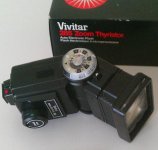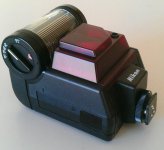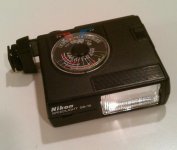I have several Vivitar 285's; they have been my main battery powered flash units for years. They are super reliable. I have a couple of external battery packs (Black Box batteries, made by Al Jacobs) to power them but you can use AA's too, of course. Al's batteries power both the older units and the newer HV units, since they receive power by modifying the battery insert and cutting a small hole in the door for a cord. I've used these flashes with many camera systems: Nikon, Canon, Leica, Sony, and various medium and large format cameras. The new HV units are best for new digital cameras, since the high voltage trigger can fry modern electronics, but if your M6 is not the TTL version it'll be fine with either. I'd only mount a HV unit to a TTL or newer Leica directly; but I use radio slaves or remote cords to trigger them from all kinds of cameras with no problems.
As for diffusers and modifiers, I use a variety of things from simple diffusion sheets and bounce cards to umbrellas and even a DIY ring flash (you can find lots of examples and plans in the internet for these, but of course they don't work with rangefinder cameras). But my favorite for regular on-camera use is the Story-Fen omni bounce. (Make sure you get the right one for your flash- they make slightly different shapes to fit loads of different flash units.) It's a simple opaque plastic box that pops over the end. Tilt the flash head up a bit and set the thyristor to the yellow setting (basically f5.6 at ISO 400) and it gives nice wide soft illumination that is perfect for shooting events. I like to drag the shutter a little to bring in more ambient light, so the slow flash sync of the Leica isn't a problem for me. I'm generally shooting at around 1/30th with flash in these situations anyway.
The only problem is that the 285 is big and bulky, and a bit out of balance on a Leica. I like the little Nikon SB30 for a small flash to mount on the hotshoe with small cameras like the Leicas. It doesn't work with the external battery packs, but it has a couple auto thyristor settings and three or four full manual power settings (besides the fancy TTL settings for Nikon) and it's tiny but provides good fill and decent close flash, and you can find them pretty cheap.
Don't listen to those who will tell you Leicas should only be used with available light. Available light is great, but it doesn't always give you the results you want. Flash is a tool photographers should know how to use effectively, regardless of what camera they are using.




